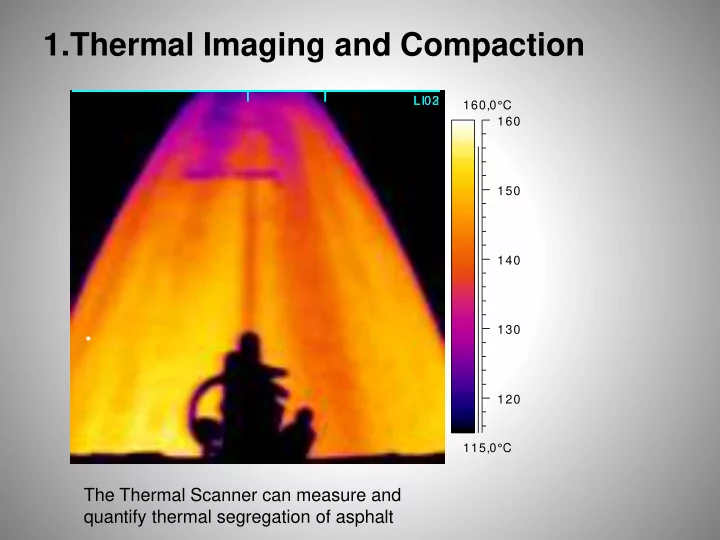

1.Thermal Imaging and Compaction LI02 LI03 160,0°C 160 150 140 130 120 115,0°C The Thermal Scanner can measure and quantify thermal segregation of asphalt
Asphalt into the Paver Hopper Asphalt behind the Paver
Thermal Scanner on the Paver
2. Why use Thermal Imaging ? • Thermal segregation can make it impossible to compact the materials to the required density. • This poorly compacted material is quite often the deciding factor for the life of the pavement • Thermal scanning is used to identify the areas of thermal segregation. • The Thermal Scanner is used as a tool to identify the factors causing the segregation. • The area of uncompactable material behind the paver Is called the “ Risk Area ”. • The main problem area was quickly identified as the transport vehicles. The insulated half pipe truck was identified as the best transport vehicle
Poor Thermal uniformity Here the effect of thermal segregation can be seen for different parts of the process. Measured as a percentage of the area behind the paver that is below what is the minimum compaction temperature. 9% of the area is uncompactable (of which 6,3 % is because of the trucks).
Transport effect on Thermal uniformity Insulated half pipe truck – Uninsulated Aluminium truck Here the difference can be seen between an insulated half pipe truck body and a standard uninsulated Aluminium body. The insulted halfpipe has an area of 0,4% that is below the minimum compaction temperature. The aluminium body has an area of 28% that is below minimum compaction temperature ( blue areas)
Very good Thermal uniformity Here the whole process has been optimised to reduce thermal Segregation resulting in a very small area of material below minimum compaction temperature. The area has been reduced to approximately 0,1%
E20 Södertälje 1998 - 2013 ABS ABb
Thermal imaging in use Scandinavia: • Substantial bonuses were paid if the half pipe truck was used. • Within 5 years the only trucks delivering asphalt were the half pipe trucks • The risk area was defined as a percentage of the paved area that was below the minimum compaction temperature. • Bonuses were paid to reduce the risk area to almost zero.
Very good Thermal Uniformity Uniform temperature of the mat behind the paver. This is the ideal situation when using a Material transfer vehicle with remixing capability.
3. Business Case for using Thermal Scanners Contractor: • Proof of quality with final inspection • Lower risk (better tendering price) • Lower Guarantee costs • Competitive advantage with tendering for contracts • Possibility for bonus (if customer understands the benefits) • With performance contracts he will have lower future maintenance costs.
4. Summary • The Thermal Scanner has given us the possibility to see the production and paving process in a completely different light. • It has enabled us to see weaknesses in the process that have huge effects on the life of the pavement. • The main benefits come when the Client sees the benefits and is willing to pay for the improvements that can be made.
Recommend
More recommend